The San Francisco Symphony’s September 29th performance of Petrushka, Violin Concerto in D major, and The Rite of Spring/La Sacre du Printemps, all masterworks composed by Igor Stravinsky, was an astounding triumph for the orchestra, for Michael Tilson Thomas, Conductor, and Stravinsky. There is so much to experience, absorb, admire in each work that any one of them could be a whole program in itself.
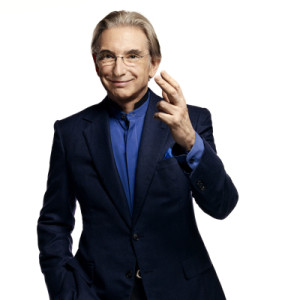 Michael Tilson Thomas, Music Director of the San Francisco Symphony
Michael Tilson Thomas, Music Director of the San Francisco Symphony
Petrushka was created for Serge Diaghilev”s Ballets Russes, 1911; the SFS performed Stravinsky’s 1947 version. The music reflects a story that takes place at a fair.
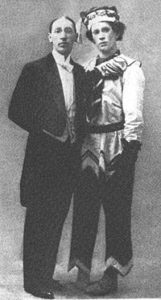 Composer Igor Stravinsky with dancer Vaslav Nijinsky costumed as Petrushka
Composer Igor Stravinsky with dancer Vaslav Nijinsky costumed as Petrushka
The Magician is able to bring three puppets to life: Petrushka, the sad puppet, loves the Ballerina who is attracted to the Moor. The puppet loses his life at the tragic end, but the fair goes on. The music uses every part of the orchestra. It features bassoon, flute, percussion, brass, strings. They make music that sounds like the environment of a fair: an organ grinder, the music coming from the puppet theater, the peasants dancing and running, a bear, a caravan, everything. Village life swirls around the audience while music imparts the mystical lives of the puppets and Magician. It transmits love, fear, and the death of a puppet only occasionally alive. There is so much wonder in Petrushka. While it could have seemed strange without the dance, the orchestra made music live fantastically on its own. Maestro Michael Tilson Thomas is an energetic, lithe dancer himself. He rises onto his toes, lifts his arms expressively, effortlessly levitates right off of the podium. The multiplicity of rhythms, tones crossing over other tones, the sounds of life mixing with authentic folk tunes all together make Petrushka an entertainment of classical brilliance.
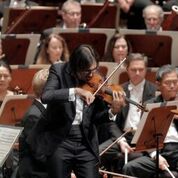 Violinist Leonidas Kavakos performing with the SF Symphony
Violinist Leonidas Kavakos performing with the SF Symphony
Stravinsky’s Violin Concerto in D major, premiered in 1931, is a great departure from the earlier Petrushka. It was written for violinist Samuel Dushkin. Its structure is novel: an introductory chord presents each of four movements, beginning with Toccata and ending with Capriccio. Aria I and Aria II fit in between. The Toccata and Capriccio are lively and, of course, inventive with bright, upbeat effects. The Arias differ from each other, but both offer lovely melodies. If this were danced, the dancer would be quick-footed, darting and flying like Puck in A Midsummer Night’s Dream. The violin soloist, Leonidas Kavakos, played as though Stravinsky were streaming it to him directly from Paradise. Kavakos made the emotion and delight of the violin become a physical presence.
And then, the full house audience, keyed up by Petrushka and the Violin Concerto, took their seats knowing that they were about to experience the famous, infamous Rite of Spring. It’s the music that caused a riot at its premiere. Actually, what could be better publicity than causing polite people in Paris to riot in the concert hall? Who wouldn’t be curious to see the ballet with the outrageous, primitive folk dances, and possibly erotic, definitely murderous plot? The power of spring-time to create life is the idea that propelled Stravinsky. The ritual depicted in the scenario devised by Stravinsky and designer Nicholas Roerich begins with the adoration of the earth. Pipers, young men foretelling the future, an old woman who knows mysteries of nature enter. There are young women with painted faces. They all dance. There is a procession of old men. They interrupt the games. All bless the earth and show they are part of it.
Next comes the sacrifice. Virgins enter and travel in circles. One is chosen to sacrifice herself. The music keeps the listener alert. Even those who know – to the extent it can be known – what is happening are on edge, alarmed by the music. It has violent, ragged rhythms. Harmonies pile on top of each other, sometimes conflicting, other times inventing new sounds by piling on. This listener, her ears trying to keep up with the jarring sounds, the changing symbolism, felt a sudden, stabbing chill. It was the end. There was a moment of quiet and then a jab. Stravinsky for all his musical innovation, was a man of the theater. The Rite of Spring, like Petrushka, is rich in folk music and rhythms. Stravinsky first claimed the folk music of Russia and Lithuania was not a resource for him; it clearly was. It is said that Modernism came into being with the Rite of Spring. Perhaps it is most modern in its assimilation of traditional music into a new form. Nothing wrong in that unless a composer wants to be only the newest and writers who want most to discover totally new art. Choreographers, first Nijinsky then Massine later the great Californian Lester Horton and Martha Graham have brought this dreadful Rite to life. With every breath, the music is full of movement. The SFS’s performance made one’s hair stand on end, and the entire audience rose to cheer.
Hearing the SFSymphony’s magnificent performance at this particular time, one notes that to praise spring, a young woman is sacrificed while old men look on. She is the Chosen One, but she is chosen to die. Something amiss in this ritual? One need not fault Roerich or Stravinsky for following a traditional line in their scenario. However, one can hear this music and mentally visualize its events while current historic events in Washington, D.C. are happening. The horror of her sacrifice overwhelms the alleged sanctity of the rite.
Photographs: Michael Tilson Thomas, courtesy of the SF Symphony; Stravinsky and Nijinsky, uncredited; Leonidas Kavakos, photo by Cory Weaver, courtesy of the SF Symphony; Nijinsky, uncredited; The Joffrey Ballet.
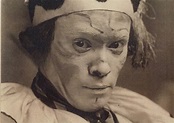
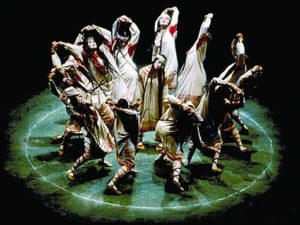 The Joffrey Ballet, in 1987, “resurrected” The Rite of Spring with Nijinsky’s original choreography. Millicent Hodson was able to reconstruct the dances, long considered lost, using Nijinsky’s notes and sketches.
The Joffrey Ballet, in 1987, “resurrected” The Rite of Spring with Nijinsky’s original choreography. Millicent Hodson was able to reconstruct the dances, long considered lost, using Nijinsky’s notes and sketches.